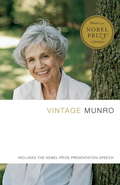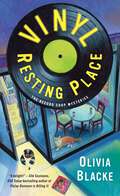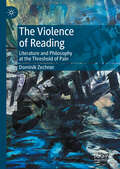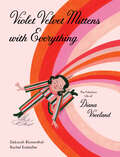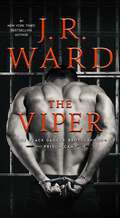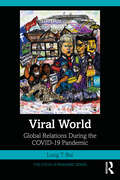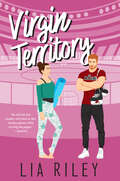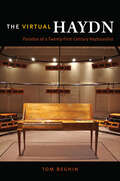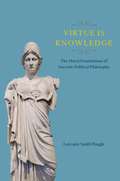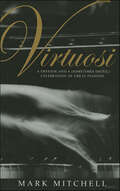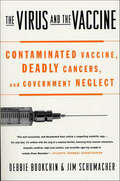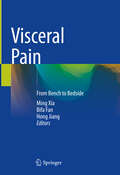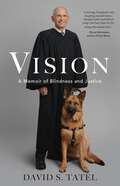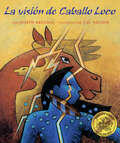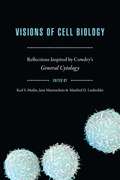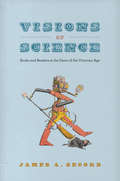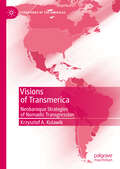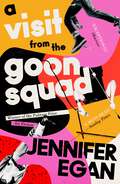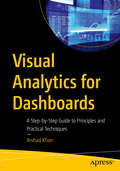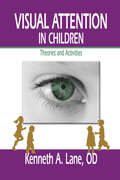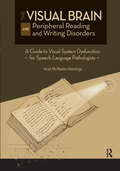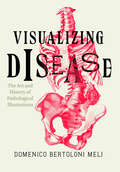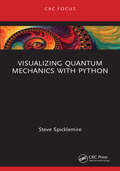- Table View
- List View
Vintage Munro: Nobel Prize Edition (Vintage International)
by Alice MunroSix of Nobel Prize–winning author Alice Munro&’s revelatory short stories that unfold the wordless secrets that lie at the center of the human experience. &“Alice Munro is often able to say more in thirty pages than an ordinary novelist is capable of in three hundred. She is a virtuoso of the elliptical . . . the master of the contemporary short story. . . . Munro, like few others, [has] come close to solving the greatest mystery of them all: the human heart and its caprices.&”—From the Presentation Speech, Nobel Prize in Literature 2013 Vintage Munro includes stories from throughout Alice Munro&’s storied career: the title stories from her collections The Moons of Jupiter; The Progress of Love; and Hateship, Friendship, Courtship, Loveship, Marriage, as well as &“Differently,&” from Friend of My Youth; &“Carried Away,&” from Open Secrets; and &“In Sight of the Lake&” from Dear Life. This edition includes the Nobel Prize Presentation Speech
Vinyl Resting Place: The Record Shop Mysteries (The Record Shop Mysteries #1)
by Olivia BlackeFirst in a new series by Olivia Blacke, Vinyl Resting Place follows three sisters who discover that opening a family business can be murder."A charming cozy for a new generation of mystery readers . . . Vinyl Resting Place is a delight!" –Elle Cosimano, USA Today bestselling author of Finlay Donovan Is Killing It"Vinyl Resting Place is bolstered by the sisters' genuine bond, colorful personalities, and not-so-gentle conflicts. It's a winning combination." -New York Times Book ReviewWhen Juni Jessup and her sisters Tansy and Maggie put all their beans in one basket to open Sip & Spin Records, a record-slash-coffee shop in Cedar River, Texas, they knew there could be some scratches on the track, but no one was expecting to find a body deader than disco in the supply closet.Family is everything to the Jessups, so when their uncle is arrested by Juni’s heartbreaking ex on suspicion of murder, the sisters don’t skip a beat putting Sip & Spin up for bail collateral. But their tune changes abruptly when Uncle Calvin disappears, leaving them in a grind. With their uncle’s freedom and the future of their small business on the line, it’s up to Juni and her sisters to get in the groove and figure out whodunit before the killer’s trail—and the coffee—goes cold.Music and mocha seem like a blend that should be “Knockin' On Heaven's Door,” but caught up in a murder investigation with her family and their life savings on the line, Juni wonders if she might be on the "Highway to Hell" instead.
The Violence of Reading: Literature and Philosophy at the Threshold of Pain
by Dominik ZechnerThe Violence of Reading: Literature and Philosophy at the Threshold of Pain expounds the scene of reading as one that produces an overwhelmed body exposed to uncontainable forms of violence. The book argues that the act of reading induces a representational instability that causes the referential function of language to collapse. This breakdown releases a type of “linguistic pain” (Scarry; Butler; Hamacher) that indicates a constitutive wounding of the reading body. The wound of language marks a rupture between linguistic reality and the phenomenal world. Exploring this rupture in various ways, the book brings together texts and genres from diverse traditions and offers close examinations of the rhetoric of masochism (Sacher-Masoch; Deleuze), the relation between reading and abuse (Nietzsche; Proust; Jelinek), the sublime experience of reading (Kant; Kafka; de Man), the “novel of the institution” (Musil; Campe), and literary suicide (Bachmann; Berryman; Okkervil River).
Violet Velvet Mittens on Everything: The Fabulous Life of Diana Vreeland
by Deborah BlumenthalThis wonderful true story of iconic fashion editor Diana Vreeland teaches young readers that individuality is to be celebrated, and that even extraordinary dreams can come true.Violet Velvet Mittens with Everything captures the dramatic, spectacular world of famed fashion icon Diana Vreeland, whose legacy at Harper's Bazaar, Vogue, and the Costume Institute of the Metropolitan Museum of Art continues to influence the fashion world today. As a little girl in Paris, Vreeland loved to read and dance, and most of all dress up. Her love of originality persisted into her career in fashion, where her work was colorful, zany, and never, ever boring. Violet Velvet Mittens with Everything captures Vreeland's larger-than-life personality with an infectiously extravagant tone and style, while showing young readers that above dazzling and daring, being yourself makes the most lasting impact of all.
The Viper (Black Dagger Brotherhood: Prison Camp #3)
by J.R. WardA heart-wrenching tale of love and betrayal in the Black Dagger Brotherhood world from #1 New York Times bestselling author J. R. Ward.Framed for the grisly murder of his shellan, Kane is condemned to the notorious prison camp—unaware of the dark truth behind his arranged mating. Centuries later, when he is horribly burned while attempting to save others, he prays he&’ll finally be reunited in the Fade with his mate…not knowing what revelations await him. Nadya is a self-taught nurse who does what she can to ease the suffering of the prisoners. When Kane comes under her care, she cannot help but empathize with his condition for very personal reasons—and as the guards take him away one last time, she fears he is facing a terrible death. After a daring rescue, Kane is offered a treatment that will change his very nature. Choosing life, for the time being, he goes back for the female who took such good care of him—but his duty to Nadya sets him on a collision course with his own past. When long-buried secrets are exposed, his self-destruction is inevitable…unless true love can save his soul.
Viral World: Global Relations During the COVID-19 Pandemic (The COVID-19 Pandemic Series)
by Long T. BuiThis book argues that the catastrophe of COVID-19 provided a momentous time for groups, institutions, and states to reassess their worldviews and relationship to the entire world. Following multiple case studies across dozens of countries throughout the course of the pandemic, this book is a timely contribution to cultural knowledge about the pandemic and the viral politics at the heart of it. Mapping the various forms of global consciousness and connectivity engendered by the crisis, the book offers the framework of "viral worlding," defined as viral forms of relationality, becoming, and communication. It demonstrates how worlding or world-making processes accelerated with the novel coronavirus. New emergent forms of being global "went viral" to address conditions of inequality as well as forge possibilities for societal transformation. Considering the tumult wrought by the pandemic, Bui analyzes progressive movements for democracy, abolition, feminism, environmentalism, and socialism against the world-shattering forces of capitalism, authoritarianism, racism, and militarism. Focusing on ways the pandemic disproportionately impacted marginalized communities, particularly in the Global South, this book juxtaposes the closing of their lifeworlds and social worlds by hegemonic global actors with increased collective demands for freedom, mobility, and justice by vulnerable people. The breadth and depth of the book thus provides students, scholars, and general readers with critical insights to understanding the world(s) of COVID-19 and collective efforts to build better new ones.
Virgin Territory: A Hellions Hockey Romance (A Hellions Hockey Romance #3)
by Lia RileyDon't miss the third and final book in Lia Riley's sexy and addictive Hellions Angels series—the perfect grumpy/sunshine beach read!Practice makes perfect...Patrick “Patch” Donnelly has what it takes to be the best goalie in the NHL... if only he could learn to control his temper. When Coach orders him to get his head in the game with private yoga classes, Patch isn’t having it. There’s no way this tough Boston guy would be caught dead downward dog-ing his way to inner peace. But if he refuses, he risks his starting position and the dream he sacrificed everything for, including joining the priesthood.Yoga instructor Margot Kowalski is over men. After yet another toxic relationship, she’s eager to forget love and focus on growing her business. Doing the Hellions head coach a favor by helping out a troubled player can't hurt, and it might give her career a high-profile boost. But free-spirited Margot is soon charming the pants off Patch. Literally. Her sassy combination of sweet and sexy proves irresistible to the goalie. Before Patch can give into temptation though, he’ll have to confess his biggest secret:He’s a virgin.But Patch is hiding more than sexual inexperience, and his dark past soon threatens to destroy his shot at true love.
The Virtual Haydn: Paradox of a Twenty-First-Century Keyboardist
by Tom BeghinHaydn’s music has been performed continuously for more than two hundred years. But what do we play, and what do we listen to, when it comes to Haydn? Can we still appreciate the rich rhetorical nuances of this music, which from its earliest days was meant to be played by professionals and amateurs alike? With The Virtual Haydn, Tom Beghin—himself a professional keyboard player—delves deeply into eighteenth-century history and musicology to help us hear a properly complex Haydn. Unusually for a scholarly work, the book is presented in the first person, as Beghin takes us on what is clearly a very personal journey into the past. When a discussion of a group of Viennese sonatas, for example, leads him into an analysis of the contemporary interest in physiognomy, Beghin applies what he learns about the role of facial expressions during his own performance of the music. Elsewhere, he analyzes gesture and gender, changes in keyboard technology, and the role of amateurs in eighteenth-century musical culture. The resulting book is itself a fascinating, bravura performance, one that partakes of eighteenth-century idiosyncrasy while drawing on a panoply of twenty-first-century knowledge.
Virtue Is Knowledge: The Moral Foundations of Socratic Political Philosophy
by Lorraine Smith PangleThe relation between virtue and knowledge is at the heart of the Socratic view of human excellence, but it also points to a central puzzle of the Platonic dialogues: Can Socrates be serious in his claims that human excellence is constituted by one virtue, that vice is merely the result of ignorance, and that the correct response to crime is therefore not punishment but education? Or are these assertions mere rhetorical ploys by a notoriously complex thinker? Lorraine Smith Pangle traces the argument for the primacy of virtue and the power of knowledge throughout the five dialogues that feature them most prominently—the Apology, Gorgias, Protagoras, Meno, and Laws—and reveals the truth at the core of these seemingly strange claims. She argues that Socrates was more aware of the complex causes of human action and of the power of irrational passions than a cursory reading might suggest. Pangle’s perceptive analyses reveal that many of Socrates’s teachings in fact explore the factors that make it difficult for humans to be the rational creatures that he at first seems to claim. Also critical to Pangle’s reading is her emphasis on the political dimensions of the dialogues. Underlying many of the paradoxes, she shows, is a distinction between philosophic and civic virtue that is critical to understanding them. Ultimately, Pangle offers a radically unconventional way of reading Socrates’s views of human excellence: Virtue is not knowledge in any ordinary sense, but true virtue is nothing other than wisdom.
Virtuosi: A Defense and a (Sometimes Erotic) Celebration of Great Pianists
by Mark MitchellVirtuosiA Defense and a (Sometimes Erotic) Celebration of Great PianistsMark MitchellA bravura performance!"Vigorous, opinionated, and always entertaining, here is a personal essayist of great charm and sincerity. Mitchell's erudition—his collection of odd and illuminating bits of knowledge—is always a delight and adds a sauce piquanteto the whole dish!" —Edmund White"...a literary work of real élan, vibrancy, and grace—the very qualities that in his view define the virtuoso. [Mr. Mitchell explores] the traditional linking of musical and sexual virtuosity, the ethical implications of the original instruments' movement, the near deification of Mozart in Anglo-Saxon culture, and, in a particularly witty section, the relationship of the virtuoso to his stool. Throughout, Mr. Mitchell's prose is humorous, intimate, and unapologeticaly polemical." —Cynthia OzickThe artistic merit of performers with superior technique has long been almost ipso facto denied. At last, Mark Mitchell launches a counterattack. In essays crackling with pianistic lore, Mitchell takes on topics such as encores, prodigies, competitions, virtuosi in film and literature, and the erotics of musical performance. Liszt, Horowitz, and Argerich share these pages with the eccentric Pachmann, Ervin Nyiregyh ("the skid-row pianist"), and Liberace. The illustrations include rare portraits of long-forgotten girl prodigies, historic concert programs, and stills from a lost 1927 film on Beethoven. Punctuating this celebration of personal voice are vignettes, running from the beginnings of the author's obsession with the piano to the particularities of concert-going in Italy (where he now lives).Mark Mitchell's piano studies led to a friendship with Vladimir Horowitz and other pianistic luminaries. With David Leavitt he co-authored Italian Pleasures and co-edited Pages Passed from Hand to Hand. He also edited The Penguin Book of International Gay Writing.
The Virus and the Vaccine: Contaminated Vaccine, Deadly Cancers, and Government Neglect
by Debbie Bookchin Jim SchumacherJonas Salk's polio vaccine has taken on an almost legendary quality as a medical miracle, for it largely eradicated one of the most feared diseases of the 20th century. But the story of the vaccine has a dark side, one that has never been fully told before...Between 1954 and 1963, close to 98 million Americans received polio vaccinations contaminated with a carcinogenic monkey virus, now known as SV40. A concerted government effort downplayed the incident, and it was generally accepted that although oncogenic to laboratory animals, SV40 was harmless to humans.But now SV40 in showing up in human cancers, and prominent researchers are demanding a serious public health response to this forgotten polio vaccine contaminant. A gripping medical detective story, The Virus and the Vaccine raises major questions about vaccine policy.
Visceral Pain: From Bench to Bedside
by Hong Jiang Ming Xia Bifa FanPatients with chronic visceral pain present a challenge for medical providers because of their vague presenting symptoms and frequent lack of identifiable pathology. Despite this, chronic visceral pain can be a debilitating medical condition that increases morbidity and decreases quality of life; the long-term consequences of which cause significant socioeconomic burden and debility. Covering the newest trends, studies, diagnosis and treatments in visceral pain care, as well as the pain treatment strategies that have been successfully employed in the past, this book brings readers fully up to date with effective recognitions and treatments for visceral pain. The clinical evaluation and presentation of common chronic visceral pain conditions and multimodal treatment options that can be used to assist patients and providers are focused.
Vision: A Memoir of Blindness and Justice
by David S. TatelThe "moving, thoughtful, and inspiring memoir" (Bryan Stevenson, author of Just Mercy) by one of America&’s most accomplished public servants and legal thinkers—who spent years denying and working around his blindness, before finally embracing it as an essential part of his identity. David Tatel has served nearly 30 years on America&’s second highest court, the United States Court of Appeals for the D.C. Circuit, where many of our most crucial cases are resolved—or teed up for the Supreme Court. He has championed equal justice for his entire adult life; decided landmark environmental and voting cases; and embodied the ideal of what a great judge should be. Yet he has been blind for the past 50 of his 80-plus years. Initially, he depended upon aides to read texts to him, and more recently, a suite of hi-tech solutions has allowed him to listen to reams of documents at high speeds. At first, he tried to hide his deteriorating vision, and for years, he denied that it had any impact on his career. Only recently, partly thanks to his first-ever guide dog, Vixen, has he come to fully accept his blindness and the role it's played in his personal and professional lives. His story of fighting for justice over many decades, with and without eyesight, is an inspiration to us all.
La visión de Caballo Loco: (Crazy Horse's Vision)
by Joseph BruchacLa verdadera historia del gran guerrero Sioux que, de joven, desafía la tradición y busca una visión propia con la esperanza de salvar a su pueblo. The true story of the great Sioux warrior who, as a young boy, defies tradition and seeks a vision on his own in hopes of saving his people.Caballo Loco (o Crazy Horse) es uno de los héroes indígenas más conocidos. Sin embargo, mucha gente no sabe que su nombre de niño era Rizos, inspirado por su cabello rizado. Rizos fue un líder incluso cuando era un niño, domaba caballos salvajes y cazaba poderosos búfalos. Pero toda su valentía no pudo prepararlo para los problemas que él y los otros Lakotas enfrentarían con los colonos blancos. Queriendo ayudar a su gente después de una feroz batalla que hirió de muerte al jefe Oso Conquistador, Rizos desafió la costumbre tradicional y arriesgó su propia vida al huir a las colinas en busca de una visión. El renombrado autor abenaki, Joseph Bruchac, cuenta una historia apasionante y convincente de cómo el joven dedicado, Rizos, se convierte en el valiente guerrero Caballo Loco. El artista sioux S.D. Nelson, con pinturas inspiradas en el estilo de libro de contabilidad de pueblos nativos de las llanuras, evoca el drama y la tragedia de una figura importante en la historia estadounidense. Crazy Horse is among the best known Native American heroes. Yet many people do not know his boyhood name was Curly, inspired by his curly hair. Curly was a leader even as a young boy, taming wild horses and hunting powerful buffalo. But all his bravery could not prepare him for the trouble he and the other Lakota Indians would face with the white settlers. Wanting to help his people after a fierce battle that mortally wounded Chief Conquering Bear, Curly defied traditional custom and risked his own life by running away, up to the hills, to seek a vision. Renowned Abenaki author Joseph Bruchac tells a gripping and compelling story of how the dedicated young boy, Curly, grows into the brave warrior Crazy Horse. Sioux artist S.D. Nelson, with paintings inspired by the ledger book style of the Plains Indians, evokes the drama and tragedy of an important figure in American history.
Visions of Cell Biology: Reflections Inspired by Cowdry's "General Cytology"
by Manfred D. LaubichlerAlthough modern cell biology is often considered to have arisen following World War II in tandem with certain technological and methodological advances—in particular, the electron microscope and cell fractionation—its origins actually date to the 1830s and the development of cytology, the scientific study of cells. By 1924, with the publication of Edmund Vincent Cowdry’s General Cytology, the discipline had stretched beyond the bounds of purely microscopic observation to include the chemical, physical, and genetic analysis of cells. Inspired by Cowdry’s classic, watershed work, this book collects contributions from cell biologists, historians, and philosophers of science to explore the history and current status of cell biology. Despite extraordinary advances in describing both the structure and function of cells, cell biology tends to be overshadowed by molecular biology, a field that developed contemporaneously. This book remedies that unjust disparity through an investigation of cell biology’s evolution and its role in pushing forward the boundaries of biological understanding. Contributors show that modern concepts of cell organization, mechanistic explanations, epigenetics, molecular thinking, and even computational approaches all can be placed on the continuum of cell studies from cytology to cell biology and beyond. The first book in the series Convening Science: Discovery at the Marine Biological Laboratory, Visions of Cell Biology sheds new light on a century of cellular discovery.
Visions of Science: Books and Readers at the Dawn of the Victorian Age
by James A. SecordThe first half of the nineteenth century witnessed an extraordinary transformation in British political, literary, and intellectual life. There was widespread social unrest, and debates raged regarding education, the lives of the working class, and the new industrial, machine-governed world. At the same time, modern science emerged in Europe in more or less its current form, as new disciplines and revolutionary concepts, including evolution and the vastness of geologic time, began to take shape. In Visions of Science, James A. Secord offers a new way to capture this unique moment of change. He explores seven key books—among them Charles Babbage’s Reflections on the Decline of Science, Charles Lyell’s Principles ofGeology, Mary Somerville’s Connexion of the Physical Sciences, and Thomas Carlyle’s Sartor Resartus—and shows how literature that reflects on the wider meaning of science can be revelatory when granted the kind of close reading usually reserved for fiction and poetry. These books considered the meanings of science and its place in modern life, looking to the future, coordinating and connecting the sciences, and forging knowledge that would be appropriate for the new age. Their aim was often philosophical, but Secord shows it was just as often imaginative, projective, and practical: to suggest not only how to think about the natural world but also to indicate modes of action and potential consequences in an era of unparalleled change. Visions of Science opens our eyes to how genteel ladies, working men, and the literary elite responded to these remarkable works. It reveals the importance of understanding the physical qualities of books and the key role of printers and publishers, from factories pouring out cheap compendia to fashionable publishing houses in London’s West End. Secord’s vivid account takes us to the heart of an information revolution that was to have profound consequences for the making of the modern world.
Visions of Transmerica: Neobaroque Strategies of Nomadic Transgression (Literatures of the Americas)
by Krzysztof A. KulawikThis book looks at Neobaroque Latin American fiction, poetry, essay and performance from the 1970s to the early 2000s in order to explore the cultural hybridization and transgressive identity transformations at play in these works. It shows how the ornamental style and boldly experimental techniques are an effective strategy in presenting decentered identities in sexually ambiguous, multiethnic, interracial, transcultural, and mutant characters, as well as in metafictional narrators and authors. In this way, the book demonstrates the potential of Neobaroque works to destabilize normative, essentialist and binary categories of identity. The study focuses on Latin America as a cultural macroregion, drawing on examples from a variety of countries, including Argentina, Uruguay, Chile, Bolivia, Brazil, Cuba, Mexico, and the US-Mexican border. Drawing on gender, queer, trans and Chicana feminist theory, it argues for an alternative approach to a model of the Self, or a theory of selfhood, derived from the exuberant style and experimental techniques of the Neobaroque.
A Visit From the Goon Squad: Emerald City, The Invisible Circus, Look At Me And A Visit From The Goon Squad
by Jennifer EganWINNER OF THE PULITZER PRIZE FOR FICTIONNEW YORK TIMES TOP 10 BOOKS OF 2010Jennifer Egan's spellbinding novel circles the lives of Bennie Salazar, an aging former punk rocker and record executive, and Sasha, the passionate, troubled young woman he employs. Although Bennie and Sasha never discover each other's pasts, the reader does, in intimate detail, along with the secret lives of a host of other characters whose paths intersect with theirs, over many years, in locales as varied as New York, San Francisco, Naples, and Africa.We first meet Sasha in her mid-thirties, on her therapist's couch in New York City, confronting her longstanding compulsion to steal. Later, we learn the genesis of her turmoil when we see her as the child of a violent marriage, then a runaway living in Naples, then as a college student trying to avert the suicidal impulses of her best friend.We meet Bennie Salazar at the melancholy nadir of his adult life-divorced, struggling to connect with his nine-year-old son, listening to a washed up band in the basement of a suburban house-and then revisit him in 1979, at the height of his youth, shy and tender, reveling in San Francisco's punk scene as he discovers his ardor for rock and roll and his gift for spotting talent. We learn what became of his high school gang-who thrived and who faltered-and we encounter Lou Kline, Bennie's catastrophically careless mentor, along with the lovers and children left behind in the wake of Lou's far flung sexual conquests and meteoric rise and fall.A Visit from the Goon Squad is a book about the interplay of time and music, about survival, about the stirrings and transformations set inexorably in motion by even the most passing conjunction of our fates. In a breathtaking array of styles and tones ranging from tragedy to satire to Powerpoint, Egan captures the undertow of self-destruction that we all must either master or succumb to; the basic human hunger for redemption; and the universal tendency to reach for both-and escape the merciless progress of time-in the transporting realms of art and music. Sly, startling, exhilarating work from one of our boldest writers.-------------------------------------------------------------------------------------------***Jennifer Egan's latest novel THE CANDY HOUSE is coming April 2022, the long-awaited sibling novel to A Visit from the Goon Squad***
Visual Analytics for Dashboards: A Step-by-Step Guide to Principles and Practical Techniques
by Arshad KhanThis book covers the key principles, best practices, and practical techniques for designing and implementing visually compelling dashboards. It explores the various stages of the dashboard development process, from understanding user needs and defining goals, to selecting appropriate visual encodings, designing effective layouts, and employing interactive elements. It also addresses the critical aspect of data storytelling, examining how narratives and context can be woven into dashboards to deliver impactful insights and engage audiences. Visual Analytics for Dashboards is designed to cater to a wide range of readers, from beginners looking to grasp the fundamentals of visual analytics, to seasoned professionals seeking to enhance their dashboard design skills. For different types of readers, such as a data analyst, BI professional, data scientist, or simply someone interested in data visualization, this book aims to equip them with the knowledge and tools necessary to create impactful dashboards. What you’ll learn The principles of data visualization How to create effective dashboards Meet all the requirements for visual analytics/data visualization/dashboard courses Deepen understanding of data presentation and analysis How to use different kinds of tools for data analysis, such as scorecards and key performance indicators Who This Book Is For Business analysts, data analysts, BI professionals, end-users, executives, developers, as well as students in dashboards, data visualizations, and visual analytics courses.
Visual Attention in Children: Theories and Activities
by Kenneth LaneIn typical child development, attention controls many aspects of learning, including memory, motor control, and problem solving. Attention organizes the constant influx of information that needs to be absorbed by children. Inside Visual Attention in Children: Theories and Activities, Dr. Kenneth A. Lane describes the positive aspects of attention that are needed for children to be successful in the classroom, such as concentration and vigilance, as opposed to negative aspects that can lead to failure, such as distractibility and confusion. This book is divided into two parts. The first eight chapters of the book explain attention and its relationship to vision and visual stimuli. The core topics discussed here include Autism, ADHD, Dyslexia, Executive Function, and Memory. The second half outlines a Vision Therapy program and consists of activities for improving visual attention in children. Over 100 activities are explained and illustrated.Visual Attention in Children: Theories and Activities is anchored on current theories in five areas of attention that shape child development.Theories Described Include:• Focused Attention – The ability to respond discreetly to visual, auditory, and tactile stimuli• Selective Attention – The ability to maintain behavioral or cognitive abilities in the face of distracting or competing stimuli• Shifting Attention – The ability to rapidly shift attention from one object to another• Sustained Attention – The ability to maintain a consistent behavioral response during a continuous or repetitive activity• Divided Attention –The ability to engage in more than one attention-focused task at one time.Visual Attention in Children: Theories and Activities is the perfect tool for occupational therapy students and clinicians as well as other professionals specializing in child development and learning who are looking to enhance their understanding of this topic and who need unique ideas and activities to add to their visual therapy training programs.
The Visual Brain and Peripheral Reading and Writing Disorders: A Guide to Visual System Dysfunction for Speech-Language Pathologists
by Heidi HeeringaThe Visual Brain and Peripheral Reading and Writing Disorders: A Guide to Visual System Dysfunction for Speech-Language Pathologists familiarizes the reader with the complex workings of the human visual system, the motor and sensory components of normal vision as they relate to the recognition of letters and words, and to the acquisition and rehabilitation of reading and writing.This text brings together findings from the neuropsychological, neurooptometric, neurolinguistic, occupational therapy, and speech-language pathology literature on acquired visual system impairment from the past 20+ years, and the ways visual system dysfunction impacts reading, writing, and cognition.Chapters Include: Review of structural elements of the eye, the cortical and subcortical structures of the visual brain, and the motor and sensory components of normal vision The distinct functions of the three primary visual pathways (central, peripheral and retinotectal) and how they relate to reading and writing Review of five formal tests of reading and writing that are designed or may be adapted to assess peripheral reading and writing disorders And much more! A few of the features inside: Figures illustrating the various components of the visual brain that are engaged when we read and write Information on visual system deficits in left hemisphere lesions with and without aphasia Detailed descriptions of peripheral reading disorders and associated error patterns Diagnostic criteria for three different types of neglect (viewer-centered, stimulus-centered, object-centered) Description of treatment materials and methods suited to clients with acquired dyslexia due to visual system dysfunction The Visual Brain and Peripheral Reading and Writing Disorders explains the heterogenous nature of peripheral reading and writing disorders, describes the association between visual motor and sensory dysfunction and the acquired dyslexias, and provides the speech-language pathologist with specific guidelines regarding the assessment and treatment of reading and writing disorders associated with visual system dysfunction.
Visual Methodologies: An Introduction to Researching with Visual Materials
by Gillian RoseHave you found some exciting images that you want to explore but don’t know how to start your research or what methods to choose? Do you have a question about an aspect of visual culture that you want to answer? Whatever level of experience you have, this classic text will provide you with the key skills you need to complete a visual methods research project, understand the rationale behind each step, and engage with the contexts and power relations that shape our interpretation of visual images. With a clear step-by-step approach that is easy to dip in and out of, the book features: •Key examples in every methods chapter to demonstrate how the methods work in practice and with different visual materials •‘Focus’ and ‘Discussion’ features that help you practice your skills at specific parts of the methods and understand some of the method’s complexities •Guidance on researching using digital visual media, such as Instagram and TikTok, integrated throughout the book This bestselling critical guide is the perfect companion to visual methods projects for undergraduates, graduates, researchers and academics across the social sciences and humanities.
Visual Methodologies: An Introduction to Researching with Visual Materials
by Gillian RoseHave you found some exciting images that you want to explore but don’t know how to start your research or what methods to choose? Do you have a question about an aspect of visual culture that you want to answer? Whatever level of experience you have, this classic text will provide you with the key skills you need to complete a visual methods research project, understand the rationale behind each step, and engage with the contexts and power relations that shape our interpretation of visual images. With a clear step-by-step approach that is easy to dip in and out of, the book features: •Key examples in every methods chapter to demonstrate how the methods work in practice and with different visual materials •‘Focus’ and ‘Discussion’ features that help you practice your skills at specific parts of the methods and understand some of the method’s complexities •Guidance on researching using digital visual media, such as Instagram and TikTok, integrated throughout the book This bestselling critical guide is the perfect companion to visual methods projects for undergraduates, graduates, researchers and academics across the social sciences and humanities.
Visualizing Disease: The Art and History of Pathological Illustrations
by Domenico Bertoloni MeliVisual anatomy books have been a staple of medical practice and study since the mid-sixteenth century. But the visual representation of diseased states followed a very different pattern from anatomy, one we are only now beginning to investigate and understand. With Visualizing Disease, Domenico Bertoloni Meli explores key questions in this domain, opening a new field of inquiry based on the analysis of a rich body of arresting and intellectually challenging images reproduced here both in black and white and in color. Starting in the Renaissance, Bertoloni Meli delves into the wide range of figures involved in the early study and representation of disease, including not just men of medicine, like anatomists, physicians, surgeons, and pathologists, but also draftsmen and engravers. Pathological preparations proved difficult to preserve and represent, and as Bertoloni Meli takes us through a number of different cases from the Renaissance to the mid-nineteenth century, we gain a new understanding of how knowledge of disease, interactions among medical men and artists, and changes in the technologies of preservation and representation of specimens interacted to slowly bring illustration into the medical world.
Visualizing Quantum Mechanics with Python
by Steve SpicklemireQuantum Mechanics can be an abstract and complex subject. Students often complain of confusion, struggle, and frustration as they try to master the topic. The goal of this book is to reduce the complexity and clarify the abstractions with concrete visual examples driven by simple python programs. It is assumed that the reader is concurrently taking a course in quantum mechanics, or self-studying quantum mechanics, but is looking for supplementary material to help with understanding and visualizing how quantum mechanics works.The focus of this book is writing python programs to visualize the underlying behavior of the mathematical theory. The background needed to understand quantum mechanics is differential equations, linear algebra and modern physics. We need a strong foundation in differential equations and linear algebra because the behavior of quantum systems is governed by equations that are written in terms of these concepts. Modern physics includes concepts such as special relativity and quantum phenomena like the photoelectric effect and energy quantization that the theory of quantum mechanics seeks to explain. This book is also not an introduction to the python programming language, or to numpy, or even to VPython. However its programming examples start simply and grow more complex as the chapters progress, so deep expertise in any of these is not a pre-requisite.Key features:· Provides an accessible and practical guide to the abstractions in quantum mechanics with concrete visual examples driven by simple python programs.· Contains few derivations, equations, and proofs.· For complete beginners of python programming, appendix B serves as a very brief introduction to the main concepts needed to understand the code in this book.Dr. Stephen Spicklemire is Associate Professor of Physics at the University of Indianapolis, USA. He has been teaching physics at the University of Indianapolis for more than 30 years. From the implementation of "flipped" physics class to the modernization of scientific computing and laboratory instrumentation courses, he has brought the strengths of his background in physics, engineering and computer science into the classroom. Dr. Spicklemire also does IT and engineering consulting. He is an active participant in several national research initiatives relating to improving physics education. These range from improving materials to help students prepare for class, to supporting students success through standards based grading. He is an active developer of the VPython and WebVPython projects and a contributor to the Matter and Interactions textbook.
